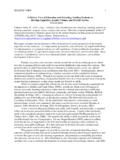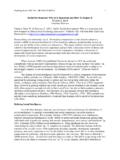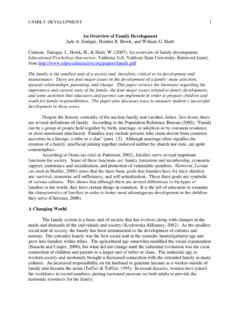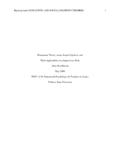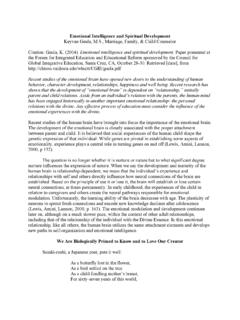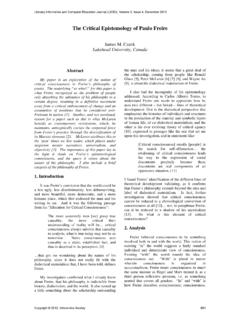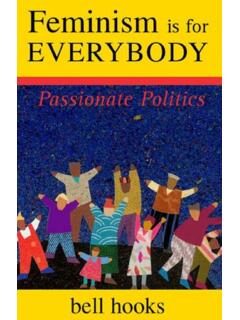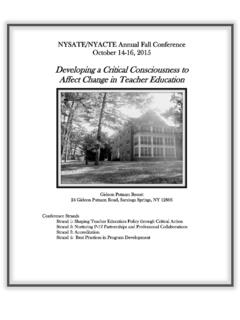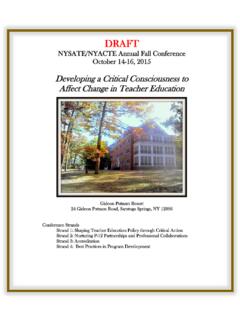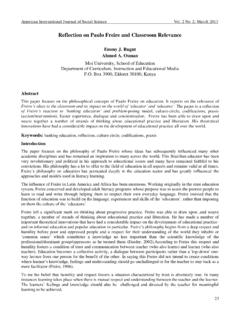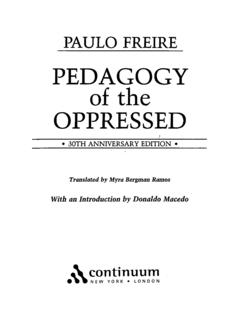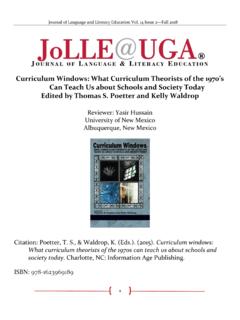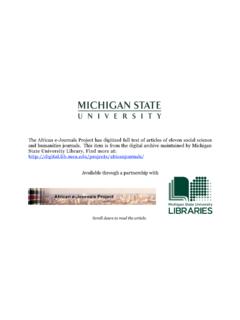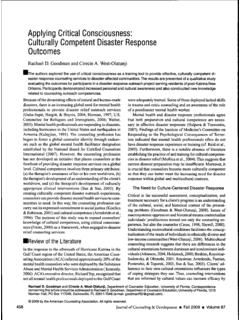Transcription of Education for critical moral consciousness - Abnl
1 Education for critical moralconsciousnessElena Mustakova-Possardt*State University of West Georgia, USAThis paper proposes a lifespan developmental model of critical moral consciousness and examinesits implications for Education in childhood, adolescence and adulthood. Mature moralconsciousness, central to negotiating the challenges of the 21st century, is characterized by adeepening lifelong integration of moral motivation, agency and critical discernment. The paperdescribes the evolution of moral consciousness through three levels; pre- critical consciousness (pCC), transitional critical consciousness (tCC) and critical consciousness (CC) and eightchronologically ascending psychosocial themes. It focuses on the rst two periods andoperationalizes the role of Education in cultivating the four dimensions of moral motivation: amoral sense of identity, a sense of responsibility and agency, a deep sense of relatedness on all levelsof living and a sense of meaning and life purpose.
2 The paper proposes a re-envisioning of educationin the direction of integrating mind and heart, developing both moral motivation and criticaldiscernment and integrating these into optimal a global revolution in the sphere of human consciousness , nothing will changefor the better in the sphere of our being as humans, and the catastrophe toward which weare headed will be unavoidable. (Havel, 1994, p. A27)The nature of moral consciousness has been a central human concern for as long ashumanity has existed. However, its comprehensive understanding and the imple-mentation of this understanding into educational practices have become de ningneeds, as we recognize our interdependence on this shrinking planet and the complexproblems we face as a human family in this age of turbulent transition to a globalcivilization (Marsella, 1998; Annan, 2002).
3 This paper presents a recently developed holistic model for the understanding ofmoral consciousness which seeks to integrate a range of discourses in moralpsychology while enriching the understanding of mature morality by drawing oncritical psychology, liberatory pedagogies and Eastern and Western spiritual philos-*Corresponding author. Psychology Department, State University of West Georgia, Carollton, GA30118, USA. Email: 0305 7240 print/ISSN 1465 3877 online/04/030245-25 2004 Journal of moral Education LtdDOI: of moral Education ,Vol. 33, No. 3, September 2004ophy. Mature moral consciousness , central to negotiating the challenges of the 21stcentury, is understood as a way of being, an optimal path of human development,which exhibits a wholesome engagement with meaning and positive change in one'ssocial world and is characterized by ever-expanding circles of agency in the service ofhumanity.
4 This moral consciousness was poignantly described by the Brazilianeducator Paolo Freire (1973) as critical consciousness :Men relate to their world in a critical way . And in the act of critical perception,men discover their own temporality. As men emerge from time, discover temporalityand free themselves from `today', their relationships with the world become impregnatedwith consequence. As men create, re-create, and decide, historical epochs begin totake shape. Whether or not men can perceive the epochal themes and above all,how they act upon the reality within which these themes are generated, will largelydetermine their humanization or dehumanization, their af rmation as subjects or theirreduction as objects. If men are unable to perceive critically the themes of theirtime, and thus to intervene actively in reality, they are carried along in the wake of change.
5 (pp. 3 7)This author has subjected to detailed analysis Freire's de nition of criticalconsciousness as the capacity to `problematize' the natural, cultural and historicalreality in which one is immersed and has studied the nature and dimensions of thiscapacity, its emergence and transformations in the lifespan and the life conditions thattend to foster or thwart its development (Mustakova-Possardt, 1996, 1998, 2000,2003).Cross-cultural interpretive analytical studyThe best thinkers of each age and culture, people as diverse as Rumi, Plato, Tolstoy,Dostoyevsky and Baha'u'llah, to mention a few, have highlighted the full rangeof aspects of this kind of consciousness . The path of optimal consciousness ismanifested in an in nite variety of ways and degrees and people move through themin widely different time frames, which have a lot to do with their life of where they are developmentally, these people always strike us asmore authentic, independent minded and resilient human beings, individuals withpresence and integrity, but not individualists.
6 These people always stand out, andothers are attracted to them and threatened at the same time, because these people t no easy mould and are not guided by personal interest. These people's livesare about truth and service, both outdated and discarded words, but they are notmoralists. If anything, they are lovers, lovers of humanity, lovers of life. Theirhearts embrace and respond deeply to the human condition. Their mindspowerfully cut through the rubble of detail and the smoke of words and reachfor inner meanings, harnessing knowledge into understanding, never just caught inthe trimmings of knowledge. These are people who, whether we love them or fearthem, represent our best hope for ourselves, that hope which we do not even order to understand the nature of this way of being, this author sought the246E.
7 Mustakova-Possardtintersections between a wide body of interdisciplinary literatures and empirical dataanalysis. The 5-year-long study (Mustakova-Possardt, 1996, 2003) relied on primarycase studies (28 in-depth interviews) and secondary life histories (Gandhi, 1927;Colby & Damon, 1992; Bembow, 1994; Dalozet al., 1996).The US interviews represented a statistically selected sub-sample of Colby andDamon's (1994) study of midlife social responsibility, which was part of theMacArthur Foundation Research Program on Successful Midlife Development(MIDMAC).1 The Bulgarian interviews were supported by the Dissertation Awardof the Henry A. Murray Research Center for the Study of Lives. They consisted ofan unrepresentative sample of four men and four women, ve of them living in thecapital and three living in a town in the heart of the country (Mustakova-Possardt,1995).
8 In 1995, when these interviews were undertaken, with the turmoil of thetransition out of communism and the efforts to articulate free and conscious publicand private choices in the context of a steadily globalizing world Bulgarian society hadbecome deeply antagonized. Lifelong interpersonal connections were being tornapart, as the historic signi cance of each person's motivations and past and presentchoices was becoming de ning in the new context of transparency in a was chosen as the cross-cultural setting because the USA and EasternEurope share the same westernized materialistic and individualistic lifestyle, colouredby a generally recognized Christian framework. In terms of the three main sectorsin every society (Malaska, 1993), economic order, socio-political order andspiritual order, both types of societies represent an imbalance.
9 In both, thespiritual order is overshadowed by, in the case of the USA and western societies,the preponderance of the economic order and, in the case of East European societies,by the preponderance of the socio-political order. Both types of societies manifestthe signs of moral and spiritual decline; both exhibit a rather frayed fabric of sociallife (Colby & Damon, 1994). Therefore, it appeared important to understandhow these socio-historical forms of organization relate to the nature of optimalconsciousness. In addition, the two societies also represent some importantvariations within the western scene. In contrast to the fundamentally individualisticcultural tradition and collective discourse of the USA, as described by Bellahet al.(1985) and Wuthnow (1991), East European societies come out of more collectivecultural, social and religious traditions.
10 Hence, a cross-cultural study hadthe potential to reveal generic and context-speci c aspects of optimal analysis followed the pattern of grounded theory (Glaser & Strauss, 1967).Open and axial thematic coding (Strauss & Corbin, 1990) of the interview datayielded empirical patterns and themes, which were then connected to patterns andthemes identi ed in the analysis of secondary life histories and case studies of socialactivists. In addition, developmental data analysis was applied, along with generic,differentiation and conditions type conceptual analysis (Soltis, 1978). The resultswere then correlated with the analysis of a wide range of theoretical literatures, seekingthe intersection of psychology, history, politics and for critical moral consciousness247 The nature and ontogenesis of critical moral consciousnessThe capacity to engage life fully and responsibly and to problematize every aspect ofthe natural, cultural and historic human reality is a whole-person phenomenon, a wayof being, which includes, but cannot be reduced to, moral identity, moral reasoning, moral affect or any other particular moral dimension.
